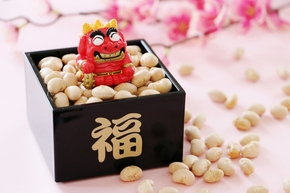Setsubun Ceremony
Update:2025/1/31
Setsubun - “Bean Throwing Ceremony”

In Japan, Setsubun (this year February 2nd) known as “the day to scatter beans and ward off demons” and especially in Osaka, is “the day to eat ehomaki (sushi rolls)”. The history of warding off demons during Setsubun is long, said to have origins as an imperial court custom during the Heian Period (8th to 11th century). The act of scattering beans is said to have arrived from China in the 15th century.
Setsubun (literally meaning “seasonal division”) originally marked the transition between the seasons and occurred 4 times a year. Perhaps the reason why only “spring Setsubun” remains is because spring is considered the beginning of the harvest year and therefore the most important season. Or perhaps it is because they felt that more protection from misfortune was needed in the season where chilly days linger and they were more susceptible to illnesses.
Ehomaki’s origin is said to have started during the Edo Period (17th to 19th century) in the merchant town of Osaka. On the night of Setsubun, there is a folklore that your wishes will come true if you eat an uncut sushi roll (makizushi) in the lucky direction of the year (“eho”), as that’s where the god of the year resides. That is west-southwest this year.
